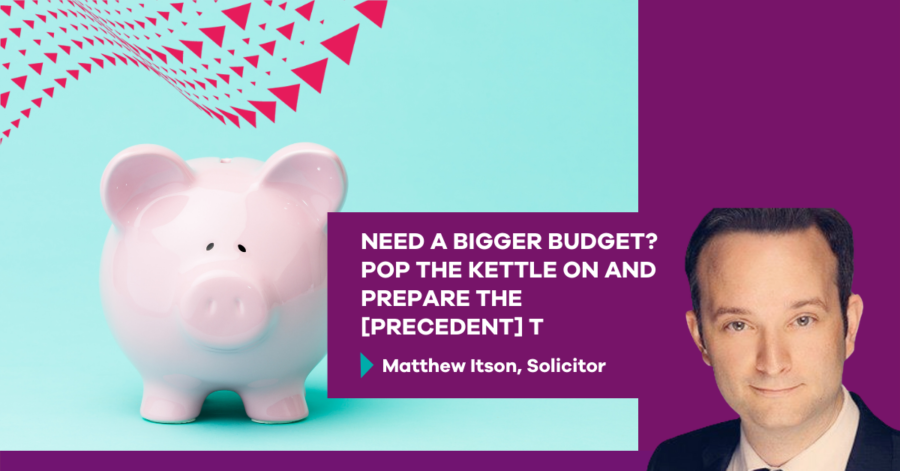Need a Bigger Budget? Pop the Kettle on and Prepare the [Precedent] T


Matthew Itson, solicitor at Minster Law, breaks down what you need to do to apply for a bigger costs budget
In litigation, as in life, there are often surprises. I think the mark of a good lawyer isn’t that you control every outcome, but that you – and certainly your client – are prepared for every eventuality, or at least the mostly likely ones, and you have the tools to respond at the ready.
I like to think of it like a chess match, gaming out all the possible scenarios, but that’s because I’m a huge nerd. Feel free to choose your own metaphor.
As in life, the best way to add to the outcomes you’re prepared for is simply to experience them. This means there’s always a stomach-churning ‘first time’ to deal with and for me, I added to my series of career ‘firsts’ earlier this year when I had to grapple with applying to vary a costs budget.
For me, varying meant applying for more costs, and I would imagine that this is the predicament in which most claimant solicitors working in personal injury find themselves, hence the thrust of this article. However, if you do realise you need to depart in any way from costs ordered by the Court, the process below is still the same.
Since October 2020, any party wishing to vary their Precedent H must use the precedent introduced to streamline the process of varying a costs budget, the Precedent T. This was needed to correct the inconsistent approaches to varying costs budgets that had caused quite a few litigants and judges a myriad of headaches in the years since costs budgeting began.
The prospect of dealing with anything costs budgeting-related in litigation can cause many solicitors to quake in their boots. So, the idea that after you’ve given the Court an account of what you’ve spent for the last 3 to 4 years and are likely to spend for the next 1 to 2 years (and hopefully ended up with a healthy chunk of this at the CCMC), you’ve got to go back to the Court cap in hand and ask for more can be enough to make one run for the hills.
But this is where cool, analytical heads prevail.
Put the kettle on, make yourself a brew and break it down into steps.
Why Can You Apply for a Bigger Budget?
Firstly, you can’t just apply if you’ve run out of the costs the Court ordered.
If you didn’t appreciate how much work there was to be done and budget accordingly in the Precedent H or if you happened to have a rather unfortunate result at the CCMC, then that’s too bad. It’s harsh, but that’s why preparation is key. It goes back to preparing for every outcome, including that a particularly frugal judge is given the task of ordering your costs budget.
Under CPR r3.15A(1), a party wishing to revise its budgeted costs can only do so ‘if significant developments in litigation warrant such revisions.’
So what is a significant development?
The process is relatively new and case law will inevitably arise with time, but there are some examples in personal injury claims that instantly spring to a claimant solicitor’s mind – the defendant applies to plead Fundamental Dishonesty, surveillance of the claimant is dropped on your desk (and your Form H assumptions expressly stated that surveillance wouldn’t be served), an expert of a discipline not budgeted for is now required to provide evidence, etc.
For me, I was fortunate enough that the question of whether it was a significant development was never really in doubt. The Court had ordered the parties budgets on the basis that the defendant was not to seek evidence from a neuropsychologist (and said as much in the budgeting Order). And then, the defendant went and got a report from a neuropsychologist.
So that seemed cut and dry.
If it doesn’t seem so clear when it happens to you, discuss it with your costs draftsman and err on the side of caution.
When and How Do You Ask for a Bigger Budget?
As it turns out, the answer of when is promptly under r3.15A(2). The answer to ‘what is promptly?’ is left up to the Court as these things are. I’m not saying that you need to file your request by the time your cuppa cools, but the key message is this: Don’t dawdle.
The general idea is that you can’t just sit on the idea once you’re aware of the significant development, but you should also see what can be agreed with your opponent before turning to the Court. Neither the judge nor your opponent will be impressed if you fire off your variation request without giving the other party the chance to work collaboratively. However, if it’s your client’s budget that you wish to vary, the onus is on you to act and to act swiftly.
My advice is to give your opponent a firm timescale by which they must respond with their views and then file the variation request come what may, hopefully with some of the variation(s) agreed.
And don’t – please don’t – just ignore the significant development and hope the claim settles. It’s tempting to relegate dealing with any budget overspends to costs negotiations, but requesting the variation now plants a flag that can be revisited in those negotiations if nothing else.
And if you delay acting, you only risk not securing those additional costs when you do get around to asking for them. After all, you may succeed on the question of a significant development occurring but could still fail on the question of whether you acted promptly and have your variation request denied.
As to ‘how do you ask’, it’s obviously the Precedent T. Apologies for spoiling this from the outset.
I’m pleased to report it’s a short, straightforward document. In fact, I was surprised by just how little space there is, as there’s really only room to say how much more (or less) you’re seeking and why and for the other party to say if the variation is agreed or why it isn’t.
There isn’t space for you to provide the Court with how the sums requested were arrived at, so you may wish to provide this in addition to the Precedent T when seeking agreement with your opponent and when filing the Precedent T. There may the slight risk of wrist-slapping for going beyond, but my view is the judge will be thankful for any calculations to assist with his or her decision
And if you’re fortunate to have a firm of costs lawyers as accessible and knowledgeable as Kain Knight as we do here at Minster Law, then this makes the process even easier. I found my costs lawyer endlessly helpful when discussing what might be a significant development, when to file the Precedent T, etc.
What Happens Next?
Once there’s clarity on what may be agreed with your opponent on your requested variation, if anything, file the Precedent T.
No matter what you and your opponent has agreed, the Court has complete discretion when making a determination, so it’s best to gird yourself and your client. It can approve, vary or even disallow the proposed variations altogether.
And it may also list a further Costs Management Hearing to determine the issues, which is when the further information explaining your maths comes in handy, as it did in my variation request.
Summary
So, getting back to steps, here is what I’d suggest when facing the need for a bigger budget (after you’ve had that cup of tea):